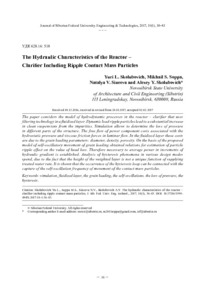Гидравлические характеристики реактора-осветлителя с учетом пульсаций частиц контактной массы
Скачать файл:
URI (для ссылок/цитирований):
https://elib.sfu-kras.ru/handle/2311/30789Автор:
Сколубович, Ю.Л.
Соппа, М.С.
Синеева, Н.В.
Сколубович, А.Ю.
Skolubovich, Yuri L.
Soppa, Mikhail S.
Sineeva, Natalya V.
Skolubovich, Alexey Y.
Дата:
2017-02Журнал:
Журнал Сибирского федерального университета. Техника и технологии. Journal of Siberian Federal University. Engineering & Technologies;2017 10 (1)Аннотация:
В статье рассмотрена модель гидродинамических процессов в реакторе-осветлителе,
использующем технологию фильтрации в псевдоожиженном слое. Динамические пульсации
частиц загрузки приводят к существенному увеличению очистки суспензий от примесей.
Моделирование позволило определить потери напора на различных участках конструкции.
В компоненте свободного течения затраты мощности связаны с гидростатическим
давлением и с силами вязкого трения в ламинарном течении. На участке псевдоожиженного
слоя эти затраты обусловлены параметрами зерен загрузки: диаметром, плотностью,
пористостью. На основе предложенной модели автоколебательного движения зерен
загрузки получены соотношения для оценки влияния пульсаций частиц на величину
потерь напора. Установлена связь необходимой осредненной мощности с приращением
гидравлического уклона. Проведен анализ гистерезисных явлений при различных режимах
работы конструкции, обусловленных тем, что высота взвешенного слоя не однозначная
функция скорости подачи очищаемой воды. Показано, что возникновение петли
гистерезиса может быть связано с захватом частоты автоколебательного движения
частиц контактной массы The paper considers the model of hydrodynamic processes in the reactor – clarifier that uses
filtering technology in a fluidized layer. Dynamic load ripple particles lead to a substantial increase
in clean suspensions from the impurities. Simulation allows to determine the loss of pressure
in different parts of the structure. The free flow of power component costs associated with the
hydrostatic pressure and viscous friction forces in laminar flow. In the fluidized layer these costs
are due to the grain loading parameters: diameter, density, porosity. On the basis of the proposed
model of self-oscillatory movement of grain loading obtained relations for estimation of particle
ripple effect on the value of head loss. Therefore necessary to average power in increments of
hydraulic gradient is established. Analysis of hysteresis phenomena in various design modes
spend, due to the fact that the height of the weighted layer is not a unique function of supplying
treated water rate. It is shown that the occurrence of the hysteresis loop can be connected with the
capture of the self-oscillation frequency of movement of the contact mass particles

